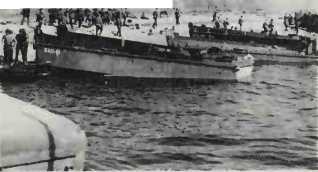And over 300 Stukas) whereas the French possessed little more than
1,000 modern aircraft. Even allowing for the British contribution, the Germans had the advantage.
In February 1940 Hitler had adopted the Manstein Plan, under which Army Group A, employing seven of the ten panzer divisions, was to penetrate the Ardennes, cross the Meuse, break out as quickly as possible and drive towards the Channel coast. Army Group B, facing the Low Countries, took the supporting role. Manstein convinced Hitler that by cutting off the Allied armies north of this deep armoured thrust, his plan would deal the enemy a crippling blow.
Between May 10 and 12 Army Group A crossed the supposedly impassable Ardennes with minimal opposition on the ground and from the air. The Meuse was reached two days earlier than the French expected and crossings began immediately on May 13. All the bridges had been blown and the defenders fought bravely, yet by the end of the day, four precarious bridgeheads had been established on the west bank.
The German thrust across the Meuse deliberately struck the junction between two weak French armies (Second and Ninth), which reeled back in confusion and panic. By nightfall on May 14 the German bridgehead was already about 30 miles (48km) wide and 15 miles (24km) deep. Heroic Anglo-French air attacks on the pontoon bridge at Sedan failed at a cost of 85 bombers (mostly Blenheims) out of 170. Worse still, by May 15, all three French armoured divisions had been shattered in ill-organized and separate counterattacks.
By May 20 the leading panzer divisions had reached the Channel near Abbeville. The order which halted the panzer forces on the Canal line between May 24 and 27 enabled most of the British (and many Allied) troops to escape at Dunkirk, but when the evacuation ceased on June 4 the first phase had ended with a resounding German victory. France had lost 30 divisions including virtually all her armour.
When the second phase of the German offensive began on June 5 the French situation was desperate, with only 66 weak divisions to
Defend a Somme line longer than the original front. Although some French units fought heroically in the final days, the end was clearly in sight when Paris fell on June 14, and Reynaud was replaced by the defeatist Petain two days later. Rommel’s 7th Panzer Division swept through to Cherbourg and the 5th to Brest causing a second, chaotic British evacuation. Meanwhile Lyons fell to XVI Corps and XIX Corps reached the Swiss border before swinging northeast to Belfort. France surrendered on June 22. BB.
France, capitulation in the Mediterranean (June 24 1940). When the Franco-Italian Armistice was signed, the main units of the French Mediterranean Fleet, away from Toulon, were under Adm Gensoul at Mers-el-Kebir (Oran), and under Adm Godfrey at Alexandria. Godfrey agreed to demilitarize his ships, but Gensoul did not. On July 3 1940, acting under Churchill’s direct orders, Adm Somerville’s Force H from Gibraltar gave Gensoul an ultimatum. When this was refused the British ships, with great reluctance, opened fire on their former allies in Mers-el-Kebir harbour. WGFJ.

Allied landing in southern France, 1944
France, Southern, Allied invasion of (August 15 1944). Carried out by Hewitt’s Allied Naval Task Force and Patch’s Seventh US Army with VI US Corps (Truscott) and French Army B (de Lattre de Tassigny), and supported by US XII Tactical Air Command (Savil-le); opposed by Nineteenth Army (Wiese), which had been seriously weakened by having to send reinforcements to Normandy.
The landings were carried out
Successfully either side of St Tropez, using overwhelming force. With the Battle of Falaise raging in Normandy, Hitler ordered a methodical withdrawal of all forces from Southern France, starting on August 18. Toulon and Marseilles fell on August 28. An attempt was made to cut off the German retreat up the Rhone Valley at Montelimar, but the American forces were not strong enough to prevent the German divisions breaking through, although the Allied air forces inflicted heavy losses during the battle. WGFJ.
Franchet d’Esperey, Marshal Louis Felix (1856-1942). Fr. Known as “Desperate Frankie” to his British allies in World War I, Franchet d’Esperey had seen extensive service outside France before 1914. In the early weeks of the 1914 campaign he commanded I Corps in Lanrezac’s Fifth Army, handling his forces superbly in the Battle of Charleroi on August 23 and leading a vital counterattack at Guise six days later. He succeeded Lanrezac at the head of the Fifth Army on September 3, in time to command it in the victory on the Marne. Towards the end of 1914 he advocated an Allied offensive in the Balkans as an alternative to the western trench stalemate, although his idea foundered on the opposition of Joffre and other French generals. Remaining on the Western Front, he was given command of the French Eastern Group of Armies in April 1916 and then, following Foch’s removal in December 1916, took over the Northern Army Group. His own career received a temporary setback when he failed to hold the German May 1918 offensive between the Aisne and Marne but, having been transferred to command the Allied Armies of the Orient in Salonika in June 1918, he was better placed to exploit his undoubted strategic flair and attacking instincts. Once his plans had won the belated approval of the Allied governments, he launched an offensive on September 15 which, within two weeks, forced. Bulgaria to sue for peace. He was created Marshal in 1922. PJS.




 World History
World History









